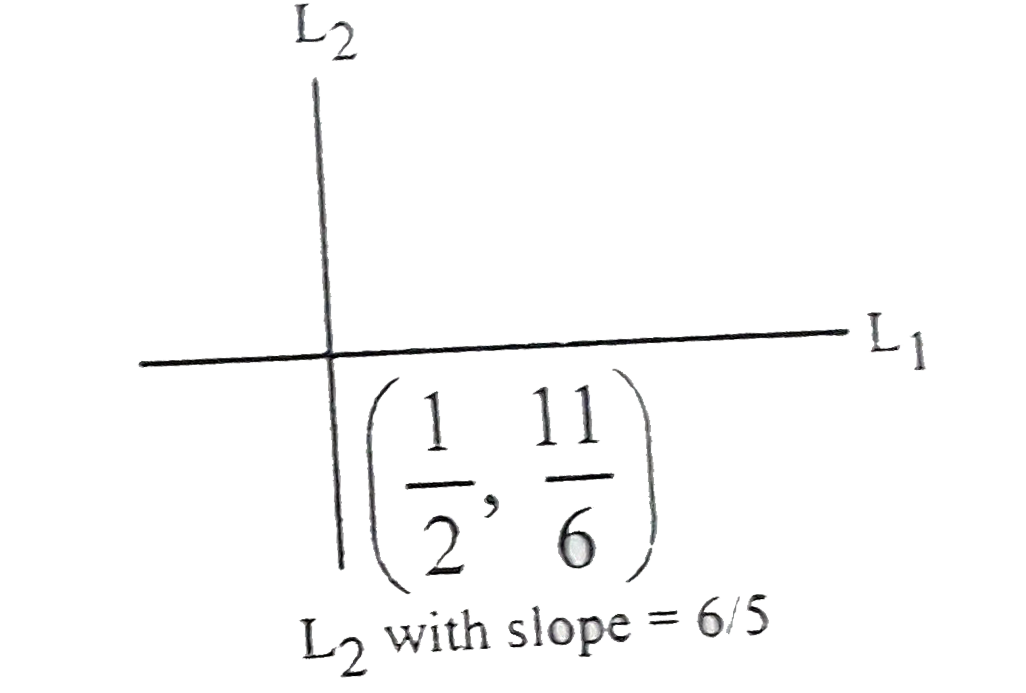Suppose the line, L1 has equation 10x−12y=−17. The line L2intersect L1 at (12,116)
and is perpendicular to L1. Find the abscissa of the point on L2 whose ordinate is (1)/(30).
Equation of L2, y−116=−65(x−12)
if y=130, 130−116=−6x5+35
16−556−3=−6x
6x=3+546=12
x=2

Topper's Solved these Questions
- BOOK - BANSALCHAPTER - TEST PAPERSEXERCISE - PHYSICS SECTION-1 Part-A (Single Correct choice Type )5videos
TEST PAPERS
- BOOK - BANSALCHAPTER - TEST PAPERSEXERCISE - PHYSICS SECTION-1 Part-A (Comprehension type )3videos
TEST PAPERS
- BOOK - BANSALCHAPTER - TEST PAPERSEXERCISE - Chemistry, SECTION-2 (PART-C)10videos
TEST PAPERS
- BOOK - BANSALCHAPTER - PROBABILITYEXERCISE - All Questions1videos
PROBABILITY
- BOOK - BANSALCHAPTER - THERMODYNAMICSEXERCISE - Match the column7videos
THERMODYNAMICS
Similar Questions
Knowledge Check
- Question 1 - Select One
Suppose that the points (h,k), (1,2) and (−3,4) lie on the line L1. If a line L2 passing through the points (h,k) and (4,3) is perpendicular to L1, then k/h equals
A−17B13C3D0 - Question 2 - Select One
A line L passeds through the points (1,1)and(2,0) and another line L' passes through (12,0) and perpendicular to L. Then the area of the triangle formed by the lines L, L' and Y-axis is
A158B254C258D2516 - Question 3 - Select One
If points (h,k)(1,2) and (−3,4) lie on line L1 and points (h,k) and (4,3) lie on L2. If L2 is perpendicular to L1, then value of hk is
A−17B13C3D7
Line L, perpendicular to the line with equation y=3x–5, contains the point (1,4). The x-intercepts of L is
View SolutionThe line l1 passing through the point (1,1) and the 'l2' passes through the point (−1,1) If the difference of the slope of lines is 2. Find the locus of the point of intersection of the l1 and l2
View SolutionIn the xy plane, the line L1 passes through the point (1,1) and the line L2 passes through the point (−1,1). If the difference of the slopes of the lines is 2. Then the locus of the point of intersection of the lines L1andL2 is
View SolutionRead the following passage and answer the questions. Consider the lines
L1:x+13=y+21=z+12
L2:x−21=y+22=z−33
Q. The distance of the point (1,1,1) from the plane passing through the point (−1,−2,−1) and whose normal is perpendicular to both the lines L1andL2, isView SolutionThe distance of the point (1,1,1) from the plane passing through the point (−1,−2,−1) and whose normal is perpandicular to both the lines L1andL2 is
View Solution

